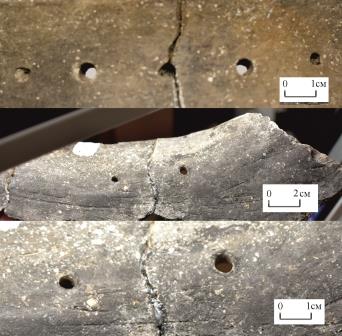Three Sketches about the Decoration and Production of the Ananyino Ware (According to the Materials of 2017 Excavations on the Ust-Nechkinskoye I Settlement in the Middle Kama Region)
DOI:
https://doi.org/10.24852/2587-6112.2023.2.258.267Keywords:
archaeological ceramics, Ananyino culture, Middle Kama region, formal and statistical methods, ceramic ware production technology, ware decorationAbstract
The paper deals with some features of ware assemblage of the Ust-Nechkinskoye I hillfort in the Middle Kama region. A brief description of the complex is given, some characteristic features of the Ananyino ceramics are marked out, that are usually not taken into account in the formal statistical analysis of the assemblages. It is claimed that three features – the presence of pits, the "collar" on the part of the vessels and the slipshod decoration at a late stage of development may be considered as the elements that are more determined by the production technology and the life cycle of ware than as decorative patterns. In this regard, the question is raised about the method of features registration and giving them weighty reasoning in the formal and statistical analysis of complexes and comparing them with each other. It is assumed that as a result of reconstruction of the technological process and understanding of the economic and cultural context of the Ananyino pottery, researches should focus on those characteristics of ware that are due to cultural, but not to technological or economic differences between the ancient groups.
References
Alabin, P. V. 1859. In Vyatskie gubernskie vedomosti (Vyatka Provincial Bulletin) 30, 207–208 (in Russian).
Sitdikov, A. G., Chizhevsky, A. A. (ed.). 2021. Rannii zheleznyi vek (Early Iron Age). Series: Arkheologiia Volgo-Uralia (Archaeology of the Volga-Urals) Vol. 3. Kazan: Institute of Archaeology named after A. Kh. Khalikov, Tatarstan Academy of Sciences (in Russian).
Ashikhmina, L. I. 1985. In Kanivets, V. I. (ed.). Arkheologicheskie pamyatniki Severnogo Priural'ya (Archaeological sites of the Northern Urals). Series: Materialy po arkheologii Evropeyskogo Severo-Vostoka (Materials on the Archaeology of North-east) 9. Syktyvkar, 55–80 (in Russian)
Ashikhmina, L. I. 2014. Genezis anan’inskoi kul’tury v Srednem Prikam’e (po materialam keramiki i zhilishch) (Genesis of the Ananyino Culture in the Middle Kama Area (According to the Ceramics and Dwellings)). Series: Arkheologiia evraziiskikh stepei (Archaeology of the Eurasian Steppes) 19. Kazan: Institute of Archaeology named after A. Kh. Khalikov, Tatarstan Academy of Sciences; “Otechestvo” Publ. (in Russian).
Tsetlin, Yu. B. 2022. (ed.). Vestnik «Istoriya keramiki» “History of Ceramics” Bulletin) 4. Moscow: Institute of Archaeology, Russian Academy of Sciences (in Russian).
Gening, V. F. 1973. In Sovetskaia Arkheologiia (Soviet Archaeology) (1), 114–136 (in Russian).
Gening, V. F., Stoianov, V. E. 1961. In Gening, V. F. (ed.). Voprosy arkheologii Urala (Issues of the Ural Archaeology) 1. Sverdlovsk, 76–90 (in Russian).
Glushkov, I. G. 1996. Keramika kak arkheologicheskiy istochnik (Ceramics as an archaeological source). Novosibirsk: Siberian Branch of the Russian Academy of Sciences, Institute for Archaeology and Ethnography (in Russian)
Goldina, R. D., Kolobova, T. A., Kazantseva, O. A., Mitriakov, A. E., Shatalov, V. A. 2013. Tarasovskoe sviatilishche rannego zheleznogo veka v srednem Prikam’e (Early Iron Age Sanctuary Tarasovo in the Middle Kama River Basin). Series: Materialy i issledovaniia Kamsko-Viatskoi arkheologicheskoi ekspeditsii (Proceedings and Research of the Kama-Vyatka Archaeological Expedition) 26. Izhevsk (in Russian).
Gutkov. A. I. 2000. In Zdanovich, S. Ya. (ed.). Arkheologicheskiy istochnik i modelirovanie drevnikh tekhnologiy: trudy muzeya–zapovednika Arkaim: sb. nauchnykh trudov (Archaeological Sources and Modeling of Ancient Technologies: Proceedings of Museum-Reserve Arkaim). Chelyabinsk: Ural Branch of the Russian Academy of Sciences, Institute for History and Archaeology, 170–186 (in Russian).
Zdanovich. D. G., Kupriyanova E.V. 2002. In Piotrovskii, Yu. Yu. (ed.). Stepi Evrazii v drevnosti i srednevekov'e (Steppes of Eurasia in Ancient Times and the Middle Ages) I. Saint Petersburg: The State Hermitage Museum, 141–145 (in Russian).
Kalinina, I. V. 2009. Ocherki po istoricheskoy semantike (Essays on historical semantics). Saint Petersburg: Saint Petersburg State University (in Russian)
Mitryakov A.E. 2011. In Rodinkova, V. E., Fedorina, A. N. (eds.). Novye materialy i metody arkheologicheskogo issledovaniia New Materials and Methods of Archaeological Studies). Moscow: Institute of Archaeology, Russian Academy of Sciences, 29–31 (in Russian).
Mitryakov, A. E. 2014. In Sitdikov, A. G. (ed.). Mezhdunarodnaia polevaia shkola v Bolgare. (International Field School in Bolgar) 1. Kazan; Bolgar: Institute of Archaeology named after A. Kh. Khalikov; Kazan (Volga Region) Federal University, 69–74 (in Russian).
Chernyh, E. M., Mitryakov, A. E. 2017. Arkheologiia Evraziiskikh stepei (Archaeology of Eurasian Steppes) 4, 17–32 (in Russian).
Chernyh, E. M., Perevozchikova, S. A. 2015. In Povolzhskaya arkheologiya (Volga River Region Archaeology) 12 (2), 114–135 (in Russian).
Chizhevsky, A.A. 2017. In Arkheologiia Evraziiskikh stepei (Archaeology of Eurasian Steppes) 4, 196–256.(in Russian).

Downloads
Published
How to Cite
Issue
Section
License
Copyright (c) 2023 A.E. Mitryakov

This work is licensed under a Creative Commons Attribution-NonCommercial 4.0 International License.







